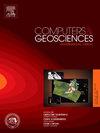基于判别器的层序语义增强地震相分析
IF 4.2
2区 地球科学
Q1 COMPUTER SCIENCE, INTERDISCIPLINARY APPLICATIONS
引用次数: 0
摘要
随着深度学习技术的快速发展,基于图像分类和图像分割模型的地震相分析技术使地震相三维密集解释成为可能。然而,深度学习模型在地震相分析中的应用目前面临着一些挑战。这些问题包括在结构复杂的地区分割地震相的困难,地震相中罕见类别的分割精度较低,以及在分割结果中存在明显的“相内噪声”。为了解决这些问题,我们提出了一种基于判别器的层序语义增强地震相分析模型(DSFA)。具体而言,该模型采用了三种主要策略:首先,使用Focal Loss函数来增强模型对具有挑战性的分割样本和稀有地震相类别的学习能力;其次,利用鉴别器输出马尔可夫随机场学习层序信息;最后,在模型的编码器和解码器之间采用跳跃式连接,整合多尺度地震剖面信息。实验结果表明,DSFA模型有效地解决了地震相分析中的普遍问题,实现了综合评价指标的最佳性能。该模型也适用于地震地貌学的研究。本文章由计算机程序翻译,如有差异,请以英文原文为准。
Discriminator-based stratigraphic sequence semantic augmentation seismic facies analysis
With the rapid development of deep learning technologies, the seismic facies analysis technique using image classification and image segmentation models has made three-dimensional dense interpretation of seismic facies feasible. However, the application of deep learning models in seismic facies analysis is currently confronted with several challenges. These include difficulties in segmenting seismic facies in structurally complex areas, lower segmentation accuracy for rare categories within seismic facies, and the presence of significant “intra-facies noise” in the segmentation results. To address these issues, we propose a Discriminator-based Stratigraphic Sequence Semantic Augmentation Seismic Facies Analysis model (DSFA). Specifically, the model employs three primary strategies: firstly, the use of the Focal Loss function to enhance the model's learning capability for challenging segmentation samples and rare seismic facies categories; secondly, the utilization of the discriminator to output a Markov Random Field for learning stratigraphic sequence information; and lastly, the adoption of Skip connections between the model's Encoder and Decoder to integrate multi-scale seismic profile information. Experimental findings reveal that the DSFA model effectively addresses prevalent issues in seismic facies analysis, achieving optimal performance across comprehensive evaluation metrics. Additionally, the model is applicable to research in seismic geomorphology.
求助全文
通过发布文献求助,成功后即可免费获取论文全文。
去求助
来源期刊

Computers & Geosciences
地学-地球科学综合
CiteScore
9.30
自引率
6.80%
发文量
164
审稿时长
3.4 months
期刊介绍:
Computers & Geosciences publishes high impact, original research at the interface between Computer Sciences and Geosciences. Publications should apply modern computer science paradigms, whether computational or informatics-based, to address problems in the geosciences.
 求助内容:
求助内容: 应助结果提醒方式:
应助结果提醒方式:


